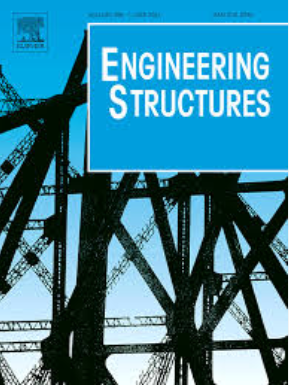Structural fire performance of steel-concrete composite girders in web shear buckling: Advanced numerical analysis
IF 5.6
1区 工程技术
Q1 ENGINEERING, CIVIL
引用次数: 0
Abstract
This study investigates the structural fire performance of steel-concrete composite plate girders prone to web shear buckling – a critical failure mode intensified by rapid and uneven heating in fire conditions. A validated numerical model developed in ABAQUS Software is used to simulate fire scenarios and assess key parameters affecting girder behavior. Through a series of parametric case studies, the influence of web geometry, load ratio, material grade, and shear connection on fire resistance is systematically explored. Results show that reducing web slenderness and panel aspect ratio significantly improves fire performance, while increasing material strength and shear connection offers limited benefits. The redistribution of shear forces during heating reveals that, prior to collapse, the concrete slab carries more than half of the total shear load due to its lower temperature and higher relative stiffness. The study also evaluates the applicability of existing analytical models for shear strength under elevated temperatures, showing improved prediction accuracy when the contribution of the concrete slab is included. This research provides new insights into the behavior of steel-concrete composite girders in fire and offers a robust numerical framework for optimizing design against fire-induced shear buckling, addressing limitations in current analytical methods.
钢-混凝土组合梁腹板剪切屈曲结构防火性能:先进数值分析
本文研究了钢-混凝土组合板梁在火灾条件下容易发生腹板剪切屈曲的结构防火性能,腹板剪切屈曲是一种因快速和不均匀加热而加剧的临界破坏模式。在ABAQUS软件中开发了一个经过验证的数值模型,用于模拟火灾场景,评估影响梁性能的关键参数。通过一系列的参数化案例研究,系统地探讨了腹板几何形状、荷载比、材料等级和剪切连接对耐火性能的影响。结果表明,降低腹板长细比和面板长径比可以显著提高防火性能,而增加材料强度和剪切连接的效果有限。在加热过程中剪切力的重新分布表明,在坍塌之前,混凝土板由于其较低的温度和较高的相对刚度,承担了一半以上的总剪切荷载。该研究还评估了现有的高温下抗剪强度分析模型的适用性,当包括混凝土板的贡献时,显示出更高的预测精度。这项研究为钢-混凝土组合梁在火灾中的行为提供了新的见解,并为针对火灾引起的剪切屈曲的优化设计提供了一个强大的数值框架,解决了当前分析方法的局限性。
本文章由计算机程序翻译,如有差异,请以英文原文为准。
求助全文
约1分钟内获得全文
求助全文
来源期刊

Engineering Structures
工程技术-工程:土木
CiteScore
10.20
自引率
14.50%
发文量
1385
审稿时长
67 days
期刊介绍:
Engineering Structures provides a forum for a broad blend of scientific and technical papers to reflect the evolving needs of the structural engineering and structural mechanics communities. Particularly welcome are contributions dealing with applications of structural engineering and mechanics principles in all areas of technology. The journal aspires to a broad and integrated coverage of the effects of dynamic loadings and of the modelling techniques whereby the structural response to these loadings may be computed.
The scope of Engineering Structures encompasses, but is not restricted to, the following areas: infrastructure engineering; earthquake engineering; structure-fluid-soil interaction; wind engineering; fire engineering; blast engineering; structural reliability/stability; life assessment/integrity; structural health monitoring; multi-hazard engineering; structural dynamics; optimization; expert systems; experimental modelling; performance-based design; multiscale analysis; value engineering.
Topics of interest include: tall buildings; innovative structures; environmentally responsive structures; bridges; stadiums; commercial and public buildings; transmission towers; television and telecommunication masts; foldable structures; cooling towers; plates and shells; suspension structures; protective structures; smart structures; nuclear reactors; dams; pressure vessels; pipelines; tunnels.
Engineering Structures also publishes review articles, short communications and discussions, book reviews, and a diary on international events related to any aspect of structural engineering.
 求助内容:
求助内容: 应助结果提醒方式:
应助结果提醒方式:


